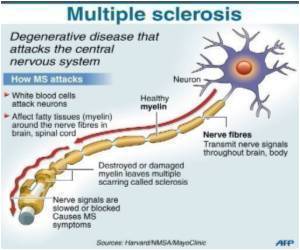
"Our results suggest that we can divide the multiple sclerosis patient population into groups that have different levels of disease activity," said De Jager. "These results motivate us to improve these distinctions with further research so that we may reach our goal of identifying the best treatment for each individual who has multiple sclerosis."
De Jager and his team extracted RNA—key molecules involved in making proteins from the instructions found in the DNA sequence—from blood cells of patients with multiple sclerosis. After analyzing the samples, they found distinct sets of RNA molecules among the patient samples. These unique sets formed a transcriptional signature that distinguished two sets of multiple sclerosis patients—MSa patients and MSb patients—with those in the MSa group having a higher risk for future multiple sclerosis relapse.
According to the researchers, knowing the category a person with multiple sclerosis is in may help doctors make more informed treatment decisions. For instance, since a patient who falls into the MSa category is more likely to experience relapse, her doctor may consider a stronger treatment for the patient.
In light of the discovery, the researchers remain cautious about the findings.
"Our study is an important step towards the goal of personalized medicine in MS, but much work remains to be done to understand under which circumstance and in combination with which other information this transcriptional signature may become useful in a clinical setting," said De Jager.
Advertisement
"The study will further enable the community of MS researchers to build upon this transcriptional signature with other data in order to enhance patient care in the future," said De Jager.
Advertisement













